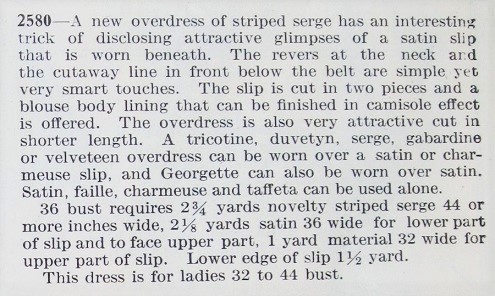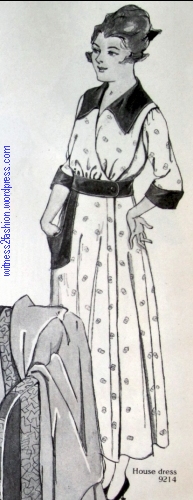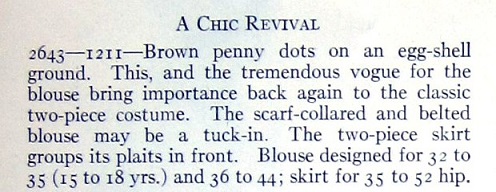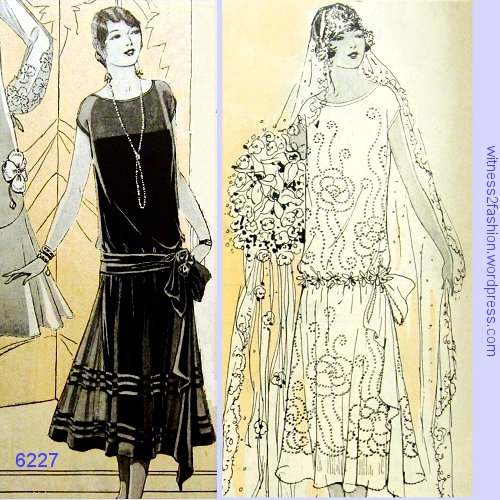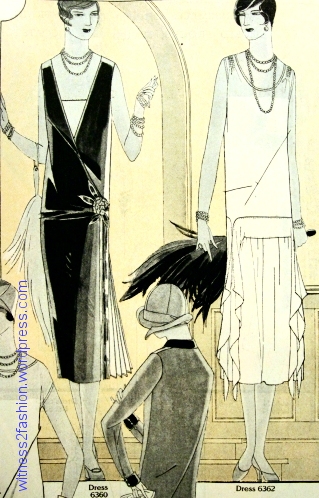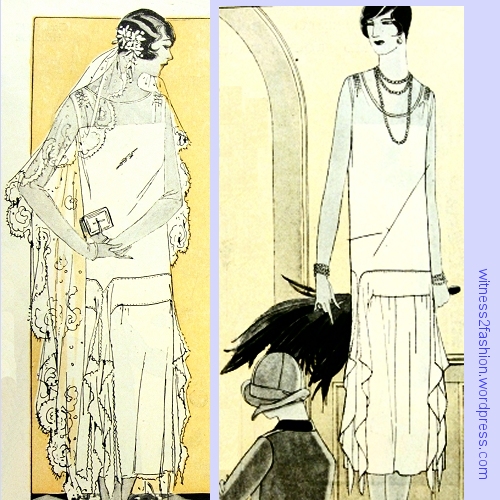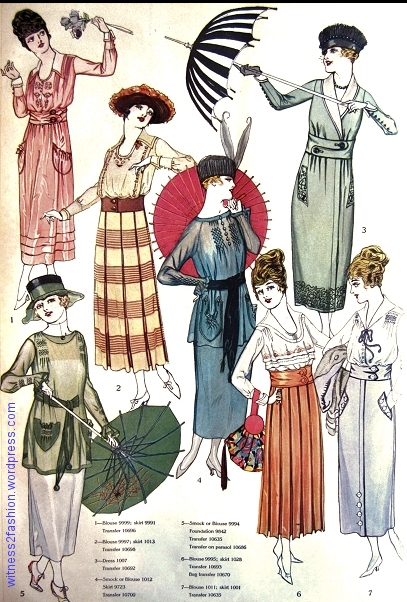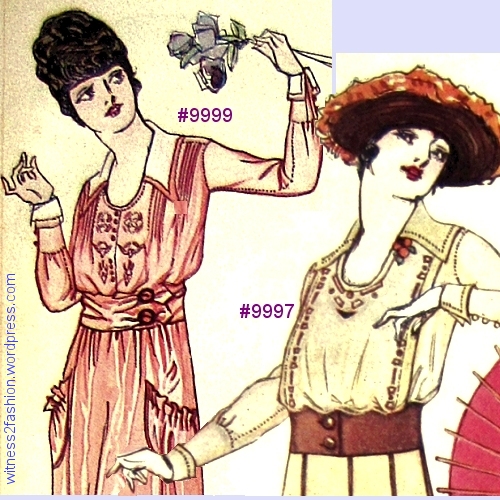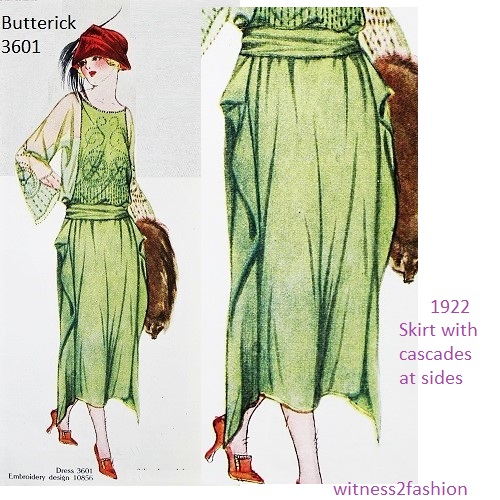
The side panels of this skirt were called “cascades.” Butterick 3601 from March, 1922; Delineator.
Cascades were created in several different ways in the Nineteen Twenties. Using the pattern archive at CoPA to better understand the options, I found a considerable variety of pattern shapes. Some cascades were basically rectangles, others were shaped, and sometimes the solution was really simple: essentially a piece of fabric wrapped around the body, with one side seam sewn several inches inside the edge of the cascade, which jutted out. (See Pattern 1408, below….)
In 1980, a Twenties’ dress with two cascades like that green one was one of my early experiments in draping. Think of the skirt as a very big pillowslip with an opening in the top seam a few inches from each side seam. That opening is gathered and attached to the bodice at the waist. I used a fairly light silk, so the bulk of the seam at each side wasn’t a problem. It looked fine, but this week I learned that it probably was not the way cascades were done in the early 1920s.
If I had had CoPA for research, I would have noticed that there was usually only one layer of fabric in the cascade.
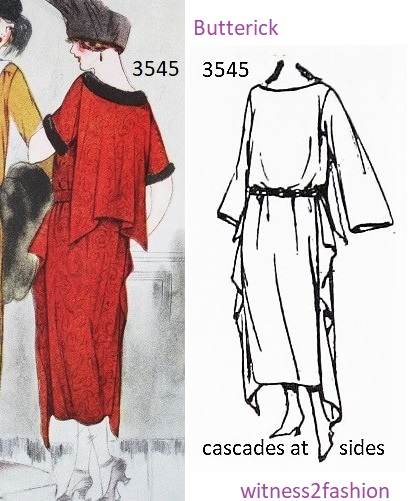
Butterick 3545 has a cascade at each side.

Pattern envelope scanned from CoPA. . “LADIES’ SLIP-OVER DRESS, closed at left underarm, with Detachable Cape, Two-Piece Skirt Attached at Low Waistline, with or without long body lining.”

Detachable Cape on Butterick 3545.

Butterick 3545 pattern layout from CoPA.

The skirt pattern pieces for Butterick 3545, 1922. Notches show where the cascades would be inserted into the side seams. This construction is very simple and logical to a 21st century stitcher.

A closer view of the skirt; Butterick 3545, 1922.
In that case, the cascade was a separate pattern piece. It was also separate in this LHJ pattern, but this cascade was shaped to taper at the bottom. And it was NOT inserted in a side seam.

The full image from CoPA of LHJ pattern 3616. A triangle of dots usually means “place on fold,” but in this case it’s hard to interpret. Notch K in the bodice front matches notch K in the skirt. The separate side panel (did it hang free?) adds to the confusion. The dress drawing does not show a center back seam.
In Ladies’ Home Journal pattern 3616, the cascade is shaped, and it has a pleat (“plait”) at the point where it is attached to the skirt waist. But the cascade does not appear to be inserted into a seam.

The right-angled point of the cascade (I called it A) hangs free, but the other side is apparently sewn to the side front of the skirt. LHJ pattern 3616.
I don’t know how the straight, raw edge of the cascade would be handled, since it doesn’t appear to be inserted in a seam, but …. (I may be misreading this one! Perhaps those five dots on the skirt are a cutting line?)
Butterick 3417, from 1921, can teach us many things.

Butterick 3417 from 1921.

Bodice, cape, and lining of Butterick 3417.
The blouson shape can be held in place by the bodice lining and the waist stay, in addition to the built-in belt we see. The cape is not just a square; the little jag at the point of attachment will affect the way the cape falls. The cascade is cut in one with the skirt front.

Skirt pieces for Butterick 3417.
This cascade is cut in one with the skirt front; the jog at the bottom allows about three inches for the skirt hem to be turned up. (The cascades apparently have a narrow hem.) The pale lavender line is my guess at the seam placement.
Butterick 3417 (1921) makes sense once you realize that the three-dot triangle means “place on fold of fabric.” I circled the small dots which mark the place where the side seams need to go. The “tube” part of the dress has a hem allowance of about 3 inches. The cascade would be narrow-hemmed, or picot hemmed, if chiffon. Yes, the back side of the fabric would be seen — no problem with georgette or reversible satin….
This Syndicate pattern, No. 1789 from 1923 has just five pieces. A seamstress would have to know about facing for the belt, which apparently buttons at one or both sides. How are the sleeves and cascades finished? How about a neck facing? Is the bodice fully lined? All up to the seamstress.

Syndicate dress 1789 from 1923.
The aerial view of this dress as it would look before the sides were sewn is very informative!

The cascades apparently hang free, outside the side seams, which probably fall vertically from the side waist And that bodice is quite intriguing. what happens when you raise your arms? Definitely wear with a slip!
Pictorial Review pattern 1408 also makes the cascade part of the skirt front:

Pictorial Review pattern 1408 from 1922. The cascade is cut in one with the skirt front.

The skirt front is seamed to the skirt back at one side (see double notches.)

There appears to be a seam line where the left side of the skirt back wraps around to the front and tucks under the cascade.
Once you match the skirt front to skirt back at one side, the entire skirt wraps around and is stitched to the front, allowing the cascade to hang free.
This beautiful 1922 dress, Ladies’ Home Journal pattern 3701, has only four pattern pieces:

LHJ pattern 3701, from 1922. (The “whole skirt” length does not seem to be to scale, since the skirt is one piece, wrapping around the body and and folding up in horizontal tucks (“plaits”) at the waist.)
I said “only four pattern pieces;” the seamstress would have to make her own bias bindings and figure out how to face the long sleeves and neckline…. (I would line the entire bodice with contrasting Chinese silk.)
Butterick 4025 makes the cascade part of its one-piece skirt.

Center, Butterick 4025, Delineator, December 1922.


Butterick 4025 pattern envelope from CoPA.

The cascade is part of the one-piece skirt. (How could the black cascade have a white reverse side, as illustrated? More dressmaker ingenuity needed….)
More often, the cascade was a separate pattern piece. In this 1923 pattern (Ladies’ Home Journal pattern 3961) the cascade on this side-closing surplice dress is cut with one curved side, for a more graceful “fall.” (“Fall, waterfall, cascade….”)

A surplice closing creates this wrap dress. Ladies’ Home Journal pattern 3961, from 1923.

Skirt pattern pieces for LHJ 3961. One-piece skirt, possibly cut on the fold at center back. (See the Three dot triangle.)

Complete pattern pieces from LHJ 3961, scanned from CoPA.
Obviously, there’s more than one way to cut a cascade. I’ve spent a lot of my life looking at old paintings and photographs and illustrations, trying to figure out how those those garments were constructed (and what the backs looked like.) One rule of the costume shop is: “Never assume.” Knowing how modern clothes are made — what “makes sense” to us — isn’t always the key to an authentic replica. CoPA, the Commercial Pattern Archive — started by theatrical costumers — is an absolute treasure. Spread the word!
Personal experience: Around 1985, I was designer and cutter for a production of Mozart’s Marriage of Figaro. One of my stitchers had been trained as a tailor in Germany. She was so unhappy with the way my men’s sleeves (patterned from Norah Waugh’s Cut of Men’s Clothes : 1600-1900) needed gathering at the back of the sleeve head that I revised my patterns for them several times. Two years later I visited the Costume Collection at the Victoria and Albert Museum, where some 18th c. men’s clothing was displayed in a case that I could walk around. Finally, I could see the back seams of the coats I had been drafting! Guess what? There were visible gathers at the back of the sleeve heads. And I had gone without sleep to get rid of them in my patterns! (P.S. That’s also why I always want to see the backs at museum exhibits! Maybe a photo? Or a mirror behind the mannequin?)












